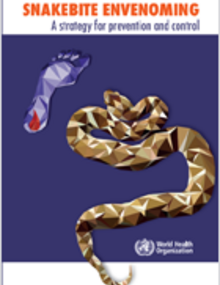Snakebite envenoming - A strategy for prevention and control

|
A disease whose time has come—Snakebite envenoming is a neglected tropical disease (NTD) that is responsible for enormous suffering, disability and premature death on every continent. As over 5.8 billion people are at risk of encountering a venomous snake, it is not surprising but no less tragic that almost 7400 people every day are bitten by snakes, and 220–380 men, women and children die as a result i, adding up to about 2.7 million cases of envenoming and 81 000–138 000 deaths a year. The economic cost of snakebite envenoming is unmanageable in most countries, as it affects not only the victims but often their entire families, particularly in poor communities in low- and middle-income countries that do not have social security. As work towards achieving the objectives of UHC2030 (https://www.uhc2030.org/) accelerates, immediate action is needed to reduce the burden of suffering of some of the world’s most disadvantaged communities, and countries around the globe have appealed for a coordinated response. Following a recommendation by WHO’s Strategic and Technical Advisory Group for Neglected Tropical Diseases and a resolution on snakebite envenoming adopted by the Seventy-first World Health Assembly in 2018, WHO has added this disease to its list of category A NTDs. It has now developed a strategy to reduce mortality and disability from snakebite envenoming by 50% before 2030. This document describes the strategy for action in countries, supported by regional collaboration, that will save lives and prevent needless suffering. A comprehensive strategy -- For millions of men, women and children around the world, the risk of snakebite is a daily concern as they go about their everyday activities – walking to school, tending gardens, herding livestock, fetching water or simply going to the toilet – where a misplaced step, a momentary lapse of concentration or being in the wrong place at the wrong time can be fatal. Reducing the problem starts with improving community education about the risk and encouraging them to seek health care and ensuring intensified case management for every patient. First aid, effective, affordable treatment provided by well-trained medical staff and rehabilitation will allow many victims to return more quickly to good health and productive lives. The core of the strategy is the goal for all patients to have better overall care, so that the numbers of deaths and cases of disability are reduced by 50% before 2030. For this to be achieved, four strategic aims will be pursued.
ASSOCIATED DOCUMENTS |
